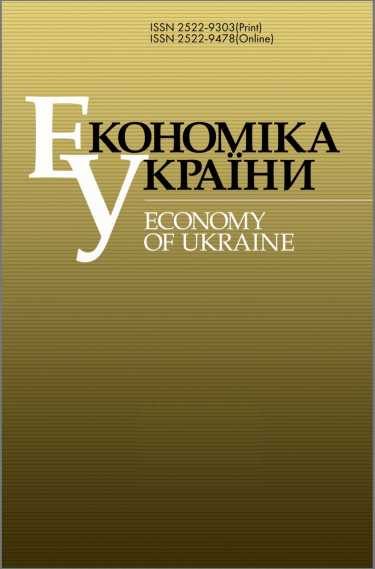ВПЛИВ РОСІЙСЬКО-УКРАЇНСЬКОЇ ВІЙНИ НА СТІЙКІСТЬ РІВНЯ ПРОДОВОЛЬЧОЇ ІНФЛЯЦІЇ В УКРАЇНІ: МОДЕЛЬ ДРОБОВОГО ІНТЕГРУВАННЯ
DOI:
https://doi.org/10.15407/economyukr.2025.01.038Ключові слова:
стійкість рівня продовольчої інфляції; російсько-українська війна; дробове інтегрування; модель ARFIMA; Україна.Анотація
Це дослідження має на меті перевірити стійкість продовольчої інфляції в Україні за допомогою методів одновимірного дробового інтегрування. Тест Гевеке — Портер-Гудак (GPH) і локальна оцінка Віттла є методами, які використовують в аналізі даних часових рядів, особливо в контексті процесів з довгою пам’яттю. На додаток до вимірювання стійкості рівня продовольчої інфляції за допомогою моделі ARFIMA емпіричні результати також свідчать про стійкість низького рівня продовольчої інфляції в Україні, хоча й з тією самою тенденцією, до й під час російсько-української війни. Крім того, рівень продовольчої інфляції має властивості довгої пам’яті, незалежно від використаної вибірки. Результати показують, що параметри пам’яті для всіх випадків (загальний, довоєнний і під час війни) перебувають у стаціонарному діапазоні (0 < d < 0,5) і є майже однаковими. Однак оцінки d свідчать про те, що ряди рівнів продовольчої інфляції демонструють довгу пам’ять, а ефект шоків зрештою зникне в короткостроковій перспективі в усіх випадках (загальний, довоєнний і під час війни). Отже, сильного впливу російсько-української війни на стійкість рівня продовольчої інфляції в Україні немає. Це вказує на те, що монетарна політика українського уряду забезпечує успішне поглинання шоків та ефективно пом’якшує наслідки російсько-української війни. Можливість додатково використовувати дробове інтегрування в одновимірному варіанті при моделюванні продовольчої інфляції є головним внеском цього дослідження, й ігнорування цієї можливості може призвести до неправильних висновків.
Посилання
Darvas, Z., Varga, B. (2014). Inflation persistence in central and eastern European countries. Applied Economics. 46(13). 1437-1448. https://doi.org/10.1080/00036846.2013.875113
Roache, S. (2014). Inflation Persistence in Brazil: A Cross Country Comparison. IMF Working Paper. No. 14/55. 23 p. https://doi.org/10.5089/9781475585230.001
Antonakakis, N., Cunado, J., Gil-Alana, L., Gupta, R. (2016). Is inflation persistence different in reality? Economics Letters. 148. 55-58. https://doi.org/10.1016/j.econlet.2016.09.003
Batini, N., Batini, N., Batini, N., Nelson, E., Nelson, E. (2001). The Lag from Monetary Policy Actions to Inflation: Friedman Revisited. International Finance. Vol. 4. Iss. 3. P. 381-400. https://doi.org/10.1111/1468-2362.00079
Fuhrer, J., Moore, G. (1995). Inflation Persistence. The Quarterly Journal of Economics. 110(1). 127-159. https://doi.org/10.2307/2118513
Bernanke, B., Gertler, M., Watson, M., Sims, C., Friedman, B. (1997). Systematic Monetary Policy and the Effects of Oil Price Shocks. Brookings Papers on Economic Activity. Vol. 1997. No. 1. P. 91-157. https://doi.org/10.2307/2534702
Alogoskoufis, G., Smith, R. (1991). The Phillips curve, the persistence of inflation, and the Lucas critique: Evidence from exchange-rate regimes. The American Economic Review. 1254-1275.
Beechey, M., Österholm, P. (2012). The rise and fall of US inflation persistence. International Journal of Central Banking. Vol. 8. No. 3. P. 55-86. URL: https://www.ijcb.org/journal/ijcb12q3a2.pdf
Bilici, B., Çekin, S. (2020). Inflation persistence in Turkey: A TVP-estimation approach. The Quarterly Review of Economics and Finance, 78, 64-69. https://doi.org/10.1016/j.qref.2020.04.002
Canepa, A. (2024). Inflation dynamics and persistence: The importance of the uncertainty channel. The North American Journal of Economics and Finance, 72, 102135. https://doi.org/10.1016/j.najef.2024.102135
Gerlach, S., Tillmann, P. (2012). Inflation targeting and inflation persistence in Asia–Pacific. Journal of Asian Economics, 23(4), 360-373. https://doi.org/10.1016/j.asieco.2012.03.002
Meller, B., Nautz, D. (2012). Inflation persistence in the Euro area before and after the European Monetary Union. Economic Modelling, 29(4), 1170-1176. https://doi.org/10.1016/j.econmod.2012.03.016
Vaona, A., Ascari, G. (2012). Regional inflation persistence: Evidence from Italy. Regional Studies, 46(4), 509-523. https://doi.org/10.1080/00343404.2010.505913
Kota, V., Lazaretou, S. (2011). The Persistence of Inflation in Albania. Special Conference Paper. No. 3. URL: https://www.bankofalbania.org/rc/doc/The_persistence_of_inflation_in_Albania_6202_2_7229.pdf
Granville, B., Zeng, N. (2019). Time variation in inflation persistence: New evidence from modelling US inflation. Economic Modelling, 81, 30-39. https://doi.org/10.1016/j.econmod.2018.12.004
Hirose, Y., Kurozumi, T., van Zandweghe, W. (2023). Inflation gap persistence, indeterminacy, and monetary policy. Review of Economic Dynamics, 51, 867-887. https://doi.org/10.1016/j.red.2023.08.007
Orphanides, A., Williams, J. (2005). Inflation scares and forecast-based monetary policy. Review of Economic Dynamics, 8(2), 498-527. https://doi.org/10.1016/j.red.2005.01.005
Brandao-Marques, L., Meeks, R., Nguyen, V. (2024). Monetary Policy with Uncertain Inflation Persistence. IMF Working Papers. No. 47. https://doi.org/10.5089/9798400269394.001
Benkhelouf, R., Sahed, A. (2023). Oil prices socks and inflation rate persistence for Algeria: a fractional co integration relationship. Economy of Ukraine, 66. 10 (743), 83-102. https://doi.org/10.15407/economyukr.2023.10.083
Benkhelouf, R., Sahed, A. (2024). Studying the relationship between the price of gold and the inflation rate persistence in Algeria using the fractional integration model. Economy of Ukraine. 67. 3(748), 72-92. https://doi.org/10.15407/economyukr.2024.03.072
Oloko, T., Ogbonna, A., Adedeji, A., Lakhani, N. (2021b). Oil price shocks and inflation rate persistence: A Fractional Cointegration VAR approach. Economic Analysis and Policy, 70, 259-275. https://doi.org/10.1016/j.eap.2021.02.014
Oloko, T., Ogbonna, A., Adedeji, A., Lakhani, N. (2021a). Fractional cointegration between gold price and inflation rate: Implication for inflation rate persistence. Resources Policy, 74, 102369. https://doi.org/10.1016/j.resourpol.2021.102369
Dua, P., Goel, D. (2021). Inflation persistence in India. Journal of Quantitative Economics, 19(3), 525-553. https://doi.org/10.1007/s40953-021-00237-z
Geronikolaou, G., Spyromitros, E., Tsintzos, P. (2020). Progressive taxation and human capital as determinants of inflation persistence. Economic Modelling, 88, 82-97. https://doi.org/10.1016/j.econmod.2019.09.011
Wu, J.-W., Wu, J.-L. (2018). Does a flexible exchange rate regime increase inflation persistence? Journal of International Money and Finance, 86, 244-263. https://doi.org/10.1016/j.jimonfin.2018.05.002
Canarella, G., Miller, S. (2016). Inflation persistence and structural breaks. Journal of Economic Studies, 43(6), 980-1005. https://doi.org/10.1108/JES-10-2015-0190
Gil-Alana, L., Carcel-Villanova, H. (2018). A fractional cointegration var analysis of exchange rate dynamics. The North American Journal of Economics and Finance, 51, 100848. https://doi.org/10.1016/j.najef.2018.09.006
Canarella, G., Miller, S. (2017a). Inflation targeting and inflation persistence: New evidence from fractional integration and cointegration. Journal of Economics and Business, 92, 45-62. https://doi.org/10.1016/J.JECONBUS.2017.05.002
Canarella, G., Miller, S. (2017b). Inflation persistence before and after inflation targeting: A fractional integration approach. Eastern Economic Journal, 43, 78-103. https://doi.org/10.1057/eej.2015.36
Dittmann, I., Granger, C. (2002). Properties of nonlinear transformations of fractionally integrated processes. Journal of Econometrics, 110(2), 113-133. https://doi.org/10.1016/S0304-4076(02)00089-1
Box, G., Jenkins, G., Reinsel, G. (2008). Model Diagnostic Checking. In: Time Series Analysis. P. 333-352. John Wiley & Sons, Ltd. https://doi.org/10.1002/9781118619193.ch8
##submission.downloads##
Опубліковано
Як цитувати
Номер
Розділ
Ліцензія
Авторське право (c) 2025 ВД "Академперіодика"

Ця робота ліцензується відповідно до Creative Commons Attribution-NonCommercial-NoDerivatives 4.0 International License.



